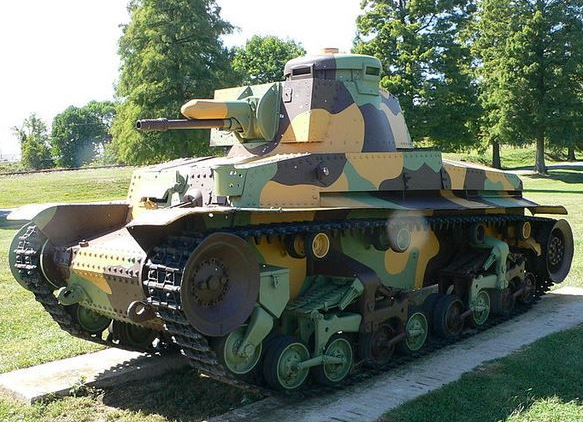In October 1934 the Czech army placed an order for two prototypes of a medium tank called the S-ll-a (or I'- ll) which were completed in the following year, Army trials with these vehicles started in June 1935 and soon uncovered many faults as a result of the tank's rushed development. Without waiting for these faults to be corrected an order was placed for a first batch of 160 vehicles in October 1935, and the first five of these were delivered in the following year. So many faults were found with these vehicles that these were returned to Skoda for modifications. A further batch of 138 was ordered for the Czech army, which called it the LT vz 35, while Romania ordered 126 under the designation R-2. Gradually most of the faults were overcome and the vehicle gained a good reputation.
 |
| Czechoslovakia providedmany of the tanks used by the Wehrmacht in the battle for France. ThePz35(t) equipped the 6th Panzer Division in that campaign, and some tanks continued in service until 1942. |
The Germans took over the remaining vehicles under the designation Panzerkampfwagen 35(t), and a further 219 were built specifically for the German army in the Skoda works. Such was the shortage of tanks in the German army at that time that the 6th Panzer Division was equipped with the PzKpfw 35(t) in time to take part in the invasion of France in 1940. These continued in service until 1942 when most of these were converted into other roles such as mortar tractors (German designation Mörserzugmittel), artillery tractors (German designation Zugkraftwagen) or maintenance vehicles with tank battalions. It is often not realized that Czechoslovakia was a leading exporter of armoured vehicles and artillery prime movers before World War II, with sales made to Austria, Bulgaria, Hungary, Latvia, Peru, Romania, Sweden, Switzerland and Turkey.
The hull of the LT vz 35 was of riveted construction that varied in thickness from 12 mm (0.47 in) to a max- imum of 35mm (1.38m). The bow machine-gunner was seated at the front of the vehicle on the left and oper- ated the 7.92-mm (0.31-in) ZB vz 35 or 37 machine-gun, with the driver to his right. The commander/gunner and loader/radio operator were seated in the two-man turret in the center of the hull. Mam armament consisted of a 37.2-mm Skoda vz 34 gun with a 7.92-mm (0.31-in) ZB 35 or 37 machine-gun mounted co-axially to the right. Totals of 72 rounds of 37 mm and 1,800 rounds of machine-gun ammunition were carried. The engine and transmission were at the rear of the hull, the trans- mission having one reverse and six for- ward gears. The suspension on each side consisted of eight small road wheels (two per bogie), with the drive sprocket at the rear, and idler at the front; there were four track-return rollers.
An unusual feature of the tank was that the transmission and steering were assisted by compressed air to reduce driver fatigue, so enabling the tank to travel long distances at high speed, Problems were encountered with these systems when the tanks were operated by the Germans on the Eastern Front because of the very low temperatures encountered.
Specification LT vz 35 Light Tank
Crew: 4
Weight: 10500 kg (23,148 lb).
Dimensions : length 4.9 m (16 ft 1 in).
Width 2.159 m (7 ft 1 in).
Height 2.209 m (7 ft 3 in).
Powerplant: one Skoda six-cylinder water-cooled petrol engine developing 120 hp (89 kW).
Performance: maximum road speed 40km/h (25 mph).
Maximum range : 193km (120 miles) .
Fording 0.8 m (3 ft 4 in).
Gradient 60 per cent.
Vertical obstacle 0.787 m (2 ft 7 in).
Trench 1,981 m (6 ft 6 in).

